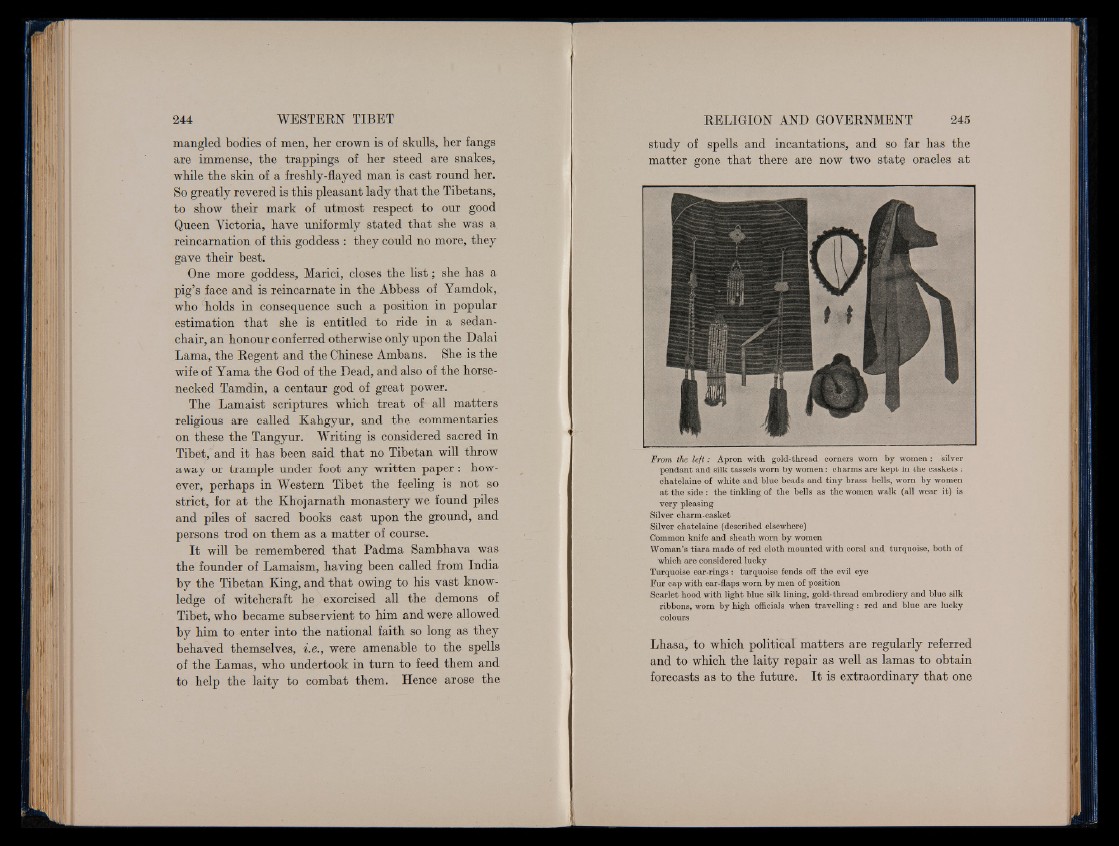
mangled bodies of men, her crown is of skulls, her fangs
are immense, the trappings of her steed are snakes,
while the skin of a freshly-flayed man is cast round her.
So greatly revered is this pleasant lady that the Tibetans,
to show their mark of utmost respect to our good
Queen Victoria, have uniformly stated that she was a
reincarnation of this goddess : they could no more, they
gave their best.
One more goddess, Marici, closes the lis t; she has a
pig’s face and is reincarnate in the Abbess of Yamdok,
who holds in consequence such a position in popular
estimation that she is entitled to ride in a sedan-
chair, an honour conferred otherwise only upon the Dalai
Lama, the Regent and the Chinese Ambans. She is the
wife of Yama the God of the Dead, and also of the horsenecked
Tamdin, a centaur god of great power.
The Lamaist scriptures which treat of' all matters
religious are called Kahgyur, and the commentaries
on these the Tangyur. Writing is considered sacred in
Tibet, and it has been said that no Tibetan will throw
away or trample under foot any written paper: however,
perhaps in Western Tibet the feeling is not so
strict, for at the Khojarnath monastery we found piles
and piles of sacred books cast upon the ground, and
persons trod on them as a matter of course.
I t will be remembered that Padma Sambhava was
the founder of Lamaism, having been called from India
by the Tibetan King, and that owing to his vast knowledge
of witchcraft he exorcised all the demons of
Tibet, who became subservient to him and were allowed
by him to enter into the national faith so long as they
behaved themselves, i.e., were amenable to the spells
of the Lamas, who undertook in turn to feed them and
to help the laity to combat them. Hence arose the
study of spells and incantations, and so far has the
matter gone that there are now two state oracles at
From the le ft: Apron with gold-thread comers worn by women: 'silver
pendant and silk tassels worn by women: charms are kept in the caskets :
chatelaine of white and blue beads and tiny brass hells, worn by women
a t the side : the tinkling of the hells as the women walk (all wear it) is
very pleasing
Silver charm-casket
Silver chatelaine (described elsewhere)
Common knife and sheath worn by women
Woman’s tiara made of red cloth mounted with coral and turquoise, both of
which are considered lucky
Turquoise ear-rings: turquoise fends off the evil eye
Fur cap with ear-flaps worn by men of position
Scarlet hood with light blue silk lining, gold-thread embrodiery and blue silk
ribbons, worn by high officials when travelling : red and blue are lucky
colours
Lhasa, to which political matters are regularly referred
and to which the laity repair as well as lamas to obtain
forecasts as to the future. I t is extraordinary that one